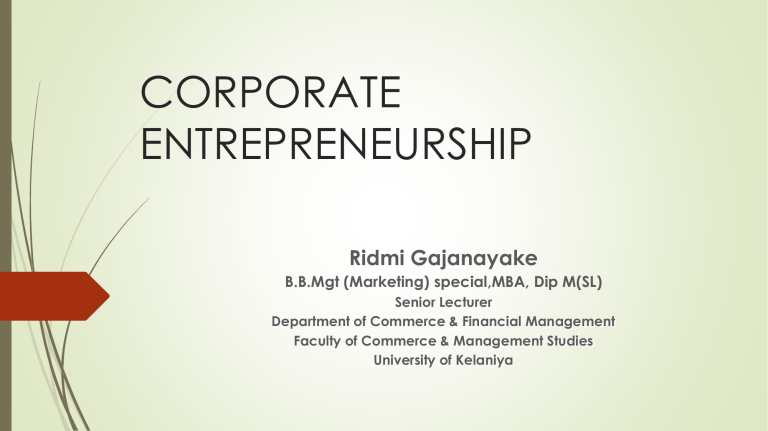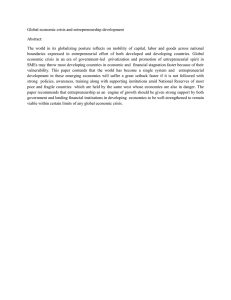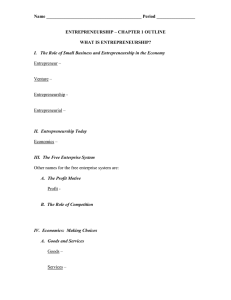
CORPORATE ENTREPRENEURSHIP Ridmi Gajanayake B.B.Mgt (Marketing) special,MBA, Dip M(SL) Senior Lecturer Department of Commerce & Financial Management Faculty of Commerce & Management Studies University of Kelaniya 2 Introduction Most established companies find it hard to maintain the initial entrepreneurial spirit that helped them to make it through during the startup stage. They need further entrepreneurial activities; - to grow - to attain competitive advantage - to keep up talent employees etc. The Need for Corporate Entrepreneuring Rapid growth in the number of new and sophisticated competitors Sense of distrust in the traditional methods of corporate management An exodus of some of the best and brightest people from corporations to become small business entrepreneurs International competition Downsizing of major corporations An overall desire to improve efficiency and productivity 3 Different Views of Corporate Entrepreneurship new business creation by individual entrepreneurs, view corporate entrepreneurship as a concept that is limited to new venture creation within existing organisations (Burgelman, 1984) the struggle of large firms to renew themselves by carrying out new combinations of resources that alter the relationships between them and their environments (Baumol, 1986; Burgelman, 1983) the process of creating new business within established firms to improve organisational profitability and enhance a firm’s competitive position or the strategic renewal of existing business (Zahara 1991) Different Views of Corporate Entrepreneurship Burgelman (1984: 154) conceptualises the definition of corporate entrepreneurship as a process of “extending the firm’s domain of competence and corresponding opportunity set through internally generated new resource combinations” Thus corporate entrepreneurship is conceived of as the effort to extend an organisation’s competitive advantage through internally generated innovations that significantly alter the balance of competition within an industry or create entirely new industries. Objectives of Corporate Entrepreneurship – Cultivate innovation and creativity within enterprise – Creating an entrepreneurial organisation – Organising around teams – Assessing enterprises as “intelligent organisations” Characteristics of Corporate Entrepreneurship •New business venturing •Innovativeness •Self renewal •Proactiveness Forms of Corporate Entrepreneurship •An established organization that enters a new business •An individual or individuals who champion new product ideas within a corporate context •A situation, where entrepreneurial philosophy permeates an entire organization’s outlook and operation INTERNAL FACTORS INFLUENCING CORPORATE ENTREPRENEURSHIP •Compensation and Incentive System •Organization Culture •Top Management Support •Organizational Structure •Resource Availability •Organization Policies •Risk Taking and Failure Tolerance BARRIERS TO CORPORATE ENTREPRENEURSHIP •Resistance to change •The Inherent nature of large organizations •Lack of Entrepreneurial talent •Inappropriate compensation methods 11 Hierarchy of Terminology in Corporate Entrepreneurship Entrepreneurship Independent Entrepreneurship Corporate Entrepreneurship Corporate Venturing Internal Corporate Venturing Innovation Strategic Renewal External Corporate Venturing (Sharma and Chrisman, 1999) 12 Independent Vs Corporate Entrepreneurship Independent entrepreneurship is the process whereby an individual or group of individuals acting independently, create a new organization. Corporate entrepreneurship is the process whereby an individual or a group of individuals, in association with an existing organization, create a new organization or instigate renewal or innovation within that organization (Sharma &Chrisman, 1999). 13 Strategic Renewal Refers to the corporate entrepreneurial efforts that result in significant changes to an organization's business or corporate level strategy or structure. These changes alter pre- existing relationships within the organization and its external environment and in most cases will involve some sort of innovation. Renewal activities reside within an existing organization and are not treated as new businesses by the organization. 14 Corporate Venturing Refers to corporate entrepreneurial efforts that lead to the creation of new business organizations or divisions within the corporate organization. They may follow from or lead to innovations that exploit new markets, or new product offerings, or both. These venturing efforts may or may not lead to the formation of new organizational units that are distinct from existing organizational units in a structural sense (e. g., a new division). 15 External corporate venturing External corporate venturing refers to corporate venturing activities that result in the creation of semi-autonomous or autonomous organizational entities that reside outside the existing organizational domain. Potential outcomes: • Joint ventures • Spin off (a type of corporate transaction forming a new company or entity) • Venture capital initiatives 16 Internal corporate venturing Internal corporate venturing refers to the corporate venturing activities that result in the creation of organizational entities that reside within an existing organizational domain. Potential outcomes: • integration • new divisions 17 Innovation Innovation is the implementation of a new or significantly improved product (good or service), or process, a new marketing method, or a new organisational method in business practices, workplace organisation or external relations (OECD, 2005). Innovation is the development and use of new ideas or behaviours in organisations (Damanpour and Wischnevsky, 2006). Innovation is the invention of ideas and its conversion to a useful application (Acs & Audretsch, 2003). 18 Difference between Creativity and Innovation Creativity is defined as the production of novel and useful ideas in any domain It is an attitude and ability It can be learnt Innovation is defined as successful implementation of creative ideas in any organization Creativity of individuals is the starting point for innovation • Creativity and innovation are normally complementary activities 19 Importance of Innovation Innovation is the main source of competitive advantage (Drucker, 1985). Innovation is an opportunity for entrepreneurial firms to gain rents through the temporary establishment of a monopoly and that they are also a key source of long-term entrepreneurial success. Innovations allow firms to establish competitively dominant positions through patents and first mover positions. Types of Innovation Radical Innovation The launching of inaugural breakthroughs. These innovations take experimentation and determined vision, which are not necessarily managed but must be recognized and nurtured. Incremental Innovation The systematic evolution of a product or service into newer or larger markets. Many times the incremental innovation will take over after a radical innovation introduces a breakthrough. 20 Reengineering Corporate Thinking Steps that will help innovative people to develop an entrepreneurial mindset: 1. Set explicit goals. 2. Create a system of feedback and positive reinforcement. 3. Emphasize individual responsibility. 4. Give rewards based on results. 5. Do not punish failures. 21 Assessing Support for Innovation Does the firm encourage entrepreneurial thinking? Does the firm provide ways for innovators to stay with their ideas? Are people permitted to do the job in their own way, or are they constantly stopping to explain their actions and ask for permission? Has the firm evolved quick and informal ways to access the resources to try new ideas? Has the firm developed ways to manage many small and experimental innovations? 22 Assessing Support for Innovation (cont’d) Is the system set up to encourage risk taking and to tolerate mistakes? Are people in your company more concerned with new ideas or with defending their turf? How easy is it to form functionally complete, autonomous teams in the firm’s corporate environment? 23 Rules for an Innovative Environment 24 1. Encourage action. 2. Use informal meetings whenever possible. 3. Tolerate failure and use it as a learning experience. 4. Persist in getting an idea to market. 5. Reward innovation for innovation’s sake. 6. Plan the physical layout of the enterprise to encourage informal communication. 7. Expect clever bootlegging of ideas—secretly working on new ideas on company time as well as personal time. 8. Put people on small teams for future-oriented projects. 9. Encourage personnel to avoid rigid procedures and bureaucratic red tape. 10. Reward and promote innovative personnel. Encouraging an Intrapreneurial Environment Steps to help restructure corporate thinking and encourage an intrapreneurial environment: 1. Early identification of potential intrapreneurs 2. Top management sponsorship of intrapreneurial projects 3. Creation of both diversity and order in strategic activities 4. Promotion of intrapreneurship through experimentation 5. Development of collaboration between intrapreneurial participants and the organization at large 25 The Need for Corporate Entrepreneuring Rapid growth in the number of new and sophisticated competitors Sense of distrust in the traditional methods of corporate management An exodus of some of the best and brightest people from corporations to become small business entrepreneurs International competition Downsizing of major corporations An overall desire to improve efficiency and productivity 26 Successful Innovative Companies Factors in large corporations that are successful innovators: Atmosphere and vision Orientation to the market Small, flat organizations Multiple approaches Interactive learning Skunkworks 27 Conceptualizing a Corporate Entrepreneurial Strategy Critical steps of a corporate entrepreneurial strategy: Developing the vision Encouraging innovation Structuring for an intrapreneurial climate Developing individual managers for corporate entrepreneurship Developing venture teams. 28 Figure 29 3.3 Shared Vision Source: Jon Arild Johannessen, “A Systematic Approach to the Problem of Rooting a Vision in the Basic Components of an Organization,” 3M’s Innovation Rules Don’t kill a project Tolerate failure Keep divisions small Motivate the champions Stay close to the customer Share the wealth 30 Structuring for a Corporate Entrepreneurial Environment Reestablishing the drive to innovate: Invest heavily in entrepreneurial activities that allow new ideas to flourish in an innovative environment. Provide nurturing and information-sharing activities. Employee perception of an innovative environment is critical. Corporate Venturing Institutionalizing the process of embracing the goal of growth through development of innovative products, processes, and technologies with an emphasis on long-term prosperity. 31 Preparing for Failure “Learning from Failure” Recognizing the importance of managing the grief process that occurs from project failure. Understanding how organizational routines and rituals are likely to influence the grief recovery. Ensuring that the organization’s social support system can encourage greater learning, foster motivational outcomes, and increase coping self-efficacy in affected individuals. 32 Developing Individual Managers for Corporate Entrepreneurship Corporate Entrepreneurship Training Program (Corporate Breakthrough Training) 1. The Breakthrough Experience 2. Breakthrough Thinking 3. Idea Acceleration Process 4. Barriers and Facilitators to Innovative Thinking 5. Sustaining Breakthrough Teams 6. The Breakthrough Plan 33 Corporate Entrepreneurship Assessment Instrument (CEAI) Key Internal Climate Factors in an Organization’s Readiness for Entrepreneurial Activity Management support Autonomy/work discretion Rewards/reinforcement Time availability Internal organizational boundaries 34 Facilitating Corporate Entrepreneurial Behavior Organizations foster entrepreneurial behavior by: Encouraging—not mandating—innovative activity Human resource policies for “selected rotation” Committing to projects long enough for momentum to occur. Bet on people, not on analysis. Rewarding Entrepreneuring: Allow inventor to take charge of the new venture Grant discretionary time to work on future projects 35 Make intracapital available for future research ideas Corporate Entrepreneurship at IBM Emerging Business Opportunity (EBO) Program’s Key Rules: Think big . . . really big. Bring in the A-team. Start small. Establish unique measurement techniques. 36 37 Thank You








